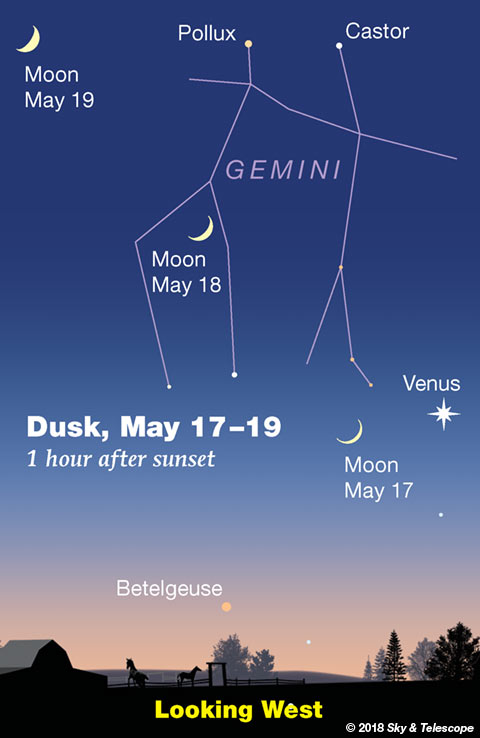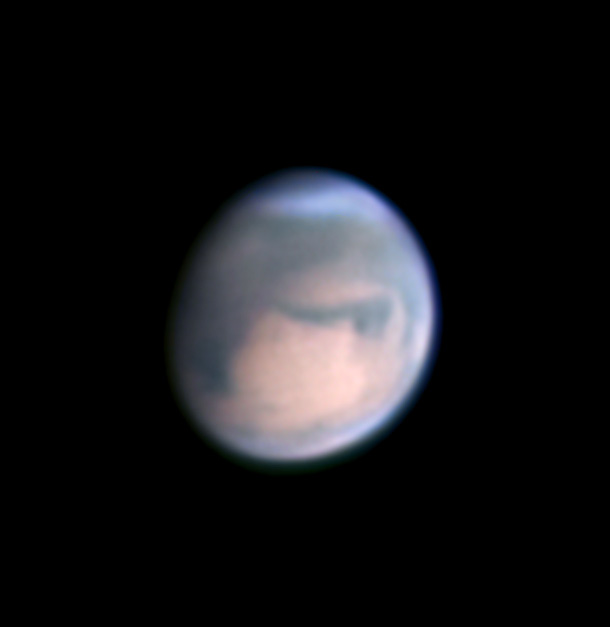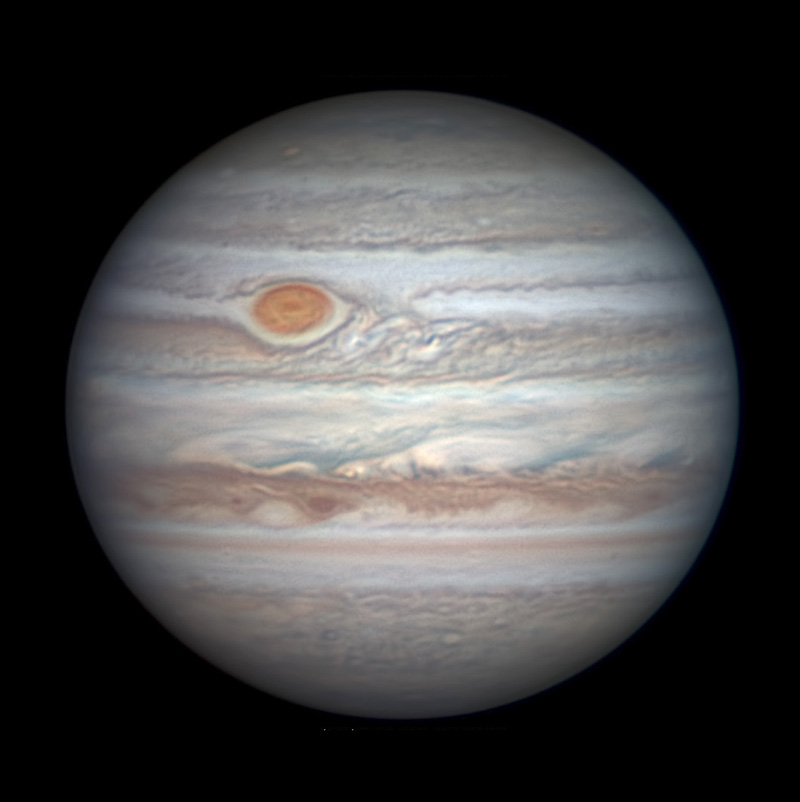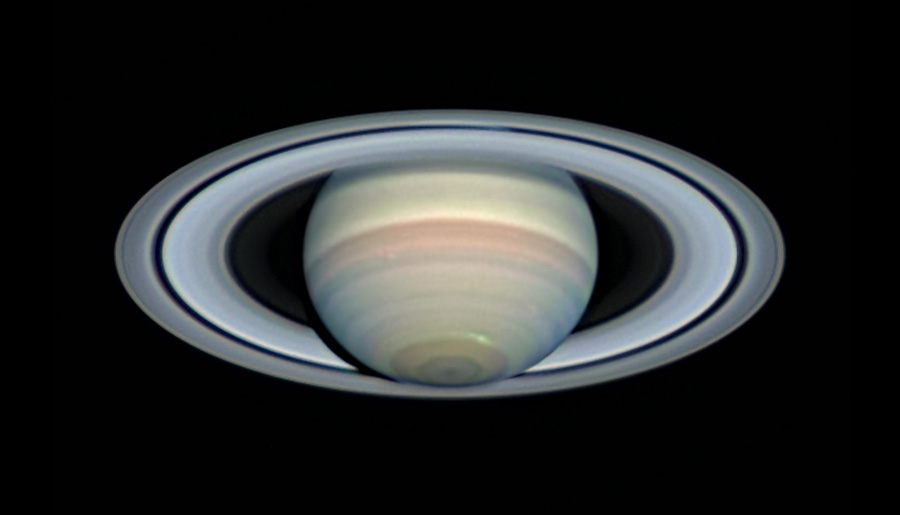Friday, May 11
• The Arch of Spring, the last part of the Winter Hexagon, spans the western sky in late twilight. Pollux and Castor form its top: they're lined up roughly horizontally in the west-northwest, about three finger-widths at arm's length apart. Look far to their lower left for Procyon, and farther to their lower right for Menkalinan and then bright Capella.
Venus glares below the Arch. Two fists at arm's length left or lower left from Venus, look for Betelgeuse twinkling on its way out.
Saturday, May 12
• Three zero-magnitude stars shine after dark in May: Arcturus very high in the southeast (high above Jupiter), Vega much lower in the northeast, and Capella in the northwest (upper right of Venus). They appear so bright because each is at least 60 times as luminous as the Sun, and because they're all relatively nearby: 37, 25, and 42 light-years from us, respectively.
Sunday, May 13
• Jupiter's biggest moon, Ganymede, crosses the planet's face from 8:53 to 10:07 p.m. Eastern Daylight Time. Following behind is its tiny black shadow, which is more readily visible in a telescope than Ganymede itself when in transit, from 9:07 to 10:52 p.m. EDT. Jupiter will be high in a dark or mostly dark sky for the Eastern time zone.
For a list of all such "phenomena of Jupiter's moons" this month, complete for observers worldwide, see the May Sky & Telescope, page 50.
Monday, May 14
• Can you see the big Coma Berenices star cluster? Does your light pollution really hide it, or do you just not know exactly where to look? It's high overhead after dark, 2/5 of the way from Denebola (Leo's tail) to the end of the Big Dipper's handle. Its brightest members form an inverted Y. The entire cluster is about 5° wide — a big, dim glow in a dark sky. It's sparse and nearly fills the view in binoculars.
• Not far away, explore the leading galaxies of the Virgo Cluster with Sue French's Deep-Sky Wonders article, photos, sketches, and chart in the May Sky & Telescope, page 54.
Tuesday, May 15
• For the rest of this spring and summer, Jupiter stays within less than 2° or 3° of 3rd-magnitude Alpha Librae (Zubenelgenubi): a fine, wide double star for binoculars. Its two components, magnitudes 2.8 and 5.1, are a generous 231 arcseconds apart. Nevertheless they form a real, gravitationally bound pair; they're both measured to be 77 light-years away.
• New Moon (exact at 7:48 a.m. Eastern Daylight Time).
Wednesday, May 16
• Vega is the brightest star in the east-northeast after dark. Look 14° (about a fist and a half at arm's length) to Vega's upper left for Eltanin, the nose of Draco the Dragon. Closer above and upper left of Eltanin are the three fainter stars of Draco's stick-figure head, also called the Lozenge. Draco always points his nose to Vega. He seems curious about it.

Thursday, May 17
• Look for the thin waxing Moon left of Venus in twilight, as shown at lower right. They're about 6° apart at the times of twilight in the Americas.
And can you say a final goodbye to setting Betelgeuse? Binoculars help.
Friday, May 18
• A binocular challenge: Just as nightfall becomes complete, spot Venus still a little above the west-northwest horizon. Get it in binoculars or a low-power, wide-field scope. Look upper left of it by about 1.6°. Can you make out the dim glow of the star cluster M35? Have you ever seen an M object so near the horizon? It'll slide closer by Venus on Saturday and Sunday nights.
Saturday, May 19
• The Moon hangs in dim Cancer. After nightfall is complete, use binoculars to look for the Beehive Star Cluster, M44, about 6° above it (as seen from North America). That's roughly the width of the field of view in typical 8x binoculars.
________________________
Want to become a better astronomer? Learn your way around the constellations! They're the key to locating everything fainter and deeper to hunt with binoculars or a telescope.
This is an outdoor nature hobby. For an easy-to-use constellation guide covering the whole evening sky, use the big monthly map in the center of each issue of Sky & Telescope, the essential guide to astronomy.

Once you get a telescope, to put it to good use you'll need a detailed, large-scale sky atlas (set of charts). The basic standard is the Pocket Sky Atlas (in either the original or Jumbo Edition), which shows stars to magnitude 7.6.
Next up is the larger and deeper Sky Atlas 2000.0, plotting stars to magnitude 8.5; nearly three times as many. The next up, once you know your way around, is the even larger Uranometria 2000.0 (stars to magnitude 9.75). And read how to use sky charts with a telescope.
You'll also want a good deep-sky guidebook, such as Sue French's Deep-Sky Wonders collection (which includes its own charts), Sky Atlas 2000.0 Companion by Strong and Sinnott, or the bigger Night Sky Observer's Guide by Kepple and Sanner.
Can a computerized telescope replace charts? Not for beginners, I don't think, and not on mounts and tripods that are less than top-quality mechanically (meaning heavy and expensive). And as Terence Dickinson and Alan Dyer say in their Backyard Astronomer's Guide, "A full appreciation of the universe cannot come without developing the skills to find things in the sky and understanding how the sky works. This knowledge comes only by spending time under the stars with star maps in hand."
This Week's Planet Roundup



Mercury (about magnitude –0.2) is having a very low, poor apparition deep in the glow of sunrise. Using binoculars, look for it 15 or 20 minutes before sunrise barely above the east horizon. Nothing else there is as bright, barring airplanes.
Venus (magnitude –3.9) shines brightly in the west-northwest during evening twilight and just after. It's as high now as it will get in twilight all spring and summer for mid-northern skywatchers. In a telescope (look early!) Venus is a little disk 12 arcseconds wide and slightly gibbous: 86% sunlit.
Mars (magnitude –0.7, at the Sagittarius-Capricornus border) rises around 1 a.m. daylight-saving time, some 20° lower left of Saturn. By early dawn in glares balefully orange in the south. Mars is brightening on its way to an unusually close opposition in late July. Already it's 12 arcseconds in apparent diameter, half its opposition width.
What detail can you see on Mars in your scope? You'll want a Mars map that identifies what features are facing Earth at your time and date, such as our free Mars Profiler.
Jupiter (magnitude –2.5, in Libra) is just past its May 8th opposition. It shines in the southeast as twilight fades, and it's the brightest point in the sky once Venus sets below the opposite horizon.
Jupiter is still at essentially its opposition diameter (44.8 arcseconds across its equator). It's highest in the south, presenting the sharpest views in a telescope, around midnight or 1 a.m. daylight-saving time. By dawn it's setting in the west-southwest.
Before Jupiter starts shrinking into the distance, see our telescopic guide to observing it in the May Sky & Telescope, page 48.
Saturn (magnitude +0.3, just above the Sagittarius Teapot) rises an hour or two after dark. It stands highest in the south just before dawn begins, about 20° to the right of brighter Mars.
Uranus is hidden in the glow of dawn.
Neptune is still low before the beginning of dawn; wait a few more weeks.
______________________
All descriptions that relate to your horizon — including the words up, down, right, and left — are written for the world's mid-northern latitudes. Descriptions that also depend on longitude (mainly Moon positions) are for North America.
Eastern Daylight Time (EDT) is Universal Time (also called UT, UTC, GMT, or Z time) minus 4 hours.
______________________
"Remember to look up at the stars and not down at your feet. Try to make sense of what you see and wonder about what makes the universe exist. Be curious."
— Stephen Hawking, 1942–2018
______________________
"The dangers of not thinking clearly are much greater now than ever before. It's not that there's something new in our way of thinking, it's that credulous and confused thinking can be much more lethal in ways it was never before."
— Carl Sagan, 1996
______________________
"Objective reality exists. Facts are often determinable. Vaccines save lives. Carbon dioxide warms the globe. Bacteria evolve to thwart antibiotics, because evolution. Science and reason are not a liberal conspiracy. They are how we determine facts. Our survival depends on our ability, and willingness, to do so."
— Alan MacRobert, your Sky at a Glance editor
______________________
"Facts are stubborn things."
— John Adams, 1770
 0
0








Comments
You must be logged in to post a comment.